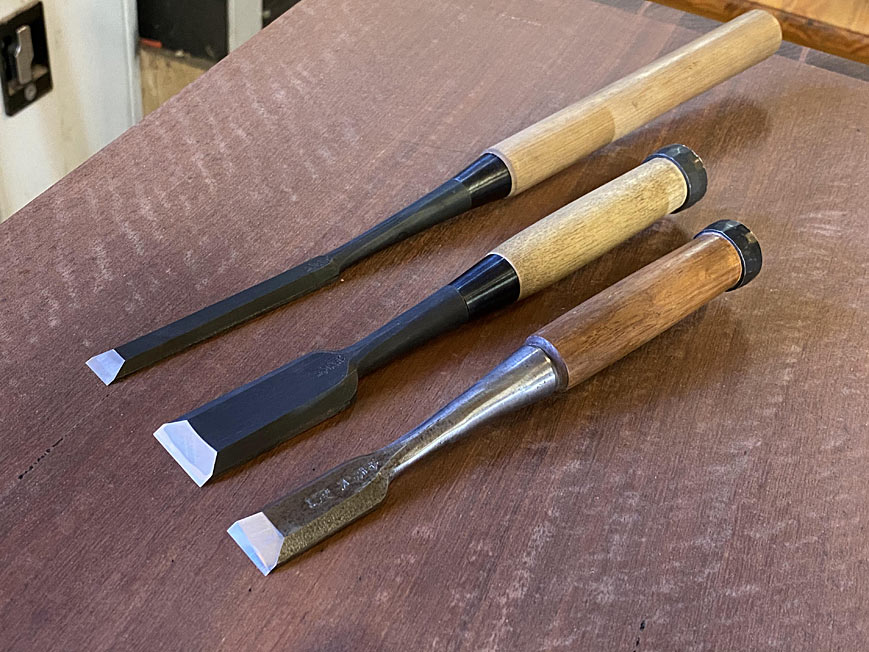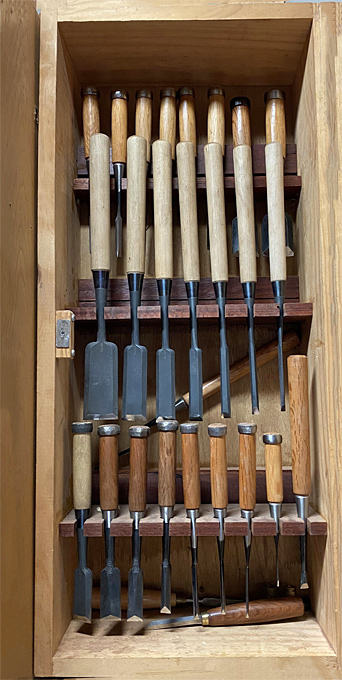derekcohen
Member
- Joined
- Jun 22, 2008
- Messages
- 972
Thanks Harvey. There are varying views on sharpening Japanese chisels.
The traditional way is to hone a flat bevel. A hollow grind is considered negatively as it is believed by many to remove the support behind the hard cutting layer and so weaken the bevel. I do not believe this having hollow ground some if the cheaper bench chisels (nomi) over many years. Jim Krenov used to add a secondary bevel as well.
I believe that the real reason is probably that the bevel just looks nicer with the laminations standing out, hard steel against soft iron, and on the more expensive chisels this can be quite beautiful.
Here are three different types I own. Kiyohisa slick (paring) and bench chisels (white paper steel) along with a PM-HSS bench chisel.

The Kiyohisa are very special, even if they do not look fancy. No longer available, and when they were there was a 6 year waiting list.
Note that the slicks are only pushed and never struck with a hammer (gennou). The bevel is 25 degrees. Bench chisels are generally at 30 degrees. I try and use these chisels in the traditional manner, and only sharpen with waterstones. In my case, Shapton Pro 1000, and Sigma 6000 and 13000.
Somewhere here are Koyamaichi dovetail chisels as well.

Bench chisels are designed to be used with a hammer (gennou), hence the hoops to reinforce the handle. This creates a tool with great precision.


To the OP: I recommend that you do some research on the use of Japanese tools and chisels before going any further. Be patient
Regards from Perth
Derek
The traditional way is to hone a flat bevel. A hollow grind is considered negatively as it is believed by many to remove the support behind the hard cutting layer and so weaken the bevel. I do not believe this having hollow ground some if the cheaper bench chisels (nomi) over many years. Jim Krenov used to add a secondary bevel as well.
I believe that the real reason is probably that the bevel just looks nicer with the laminations standing out, hard steel against soft iron, and on the more expensive chisels this can be quite beautiful.
Here are three different types I own. Kiyohisa slick (paring) and bench chisels (white paper steel) along with a PM-HSS bench chisel.

The Kiyohisa are very special, even if they do not look fancy. No longer available, and when they were there was a 6 year waiting list.
Note that the slicks are only pushed and never struck with a hammer (gennou). The bevel is 25 degrees. Bench chisels are generally at 30 degrees. I try and use these chisels in the traditional manner, and only sharpen with waterstones. In my case, Shapton Pro 1000, and Sigma 6000 and 13000.
Somewhere here are Koyamaichi dovetail chisels as well.

Bench chisels are designed to be used with a hammer (gennou), hence the hoops to reinforce the handle. This creates a tool with great precision.


To the OP: I recommend that you do some research on the use of Japanese tools and chisels before going any further. Be patient
Regards from Perth
Derek
